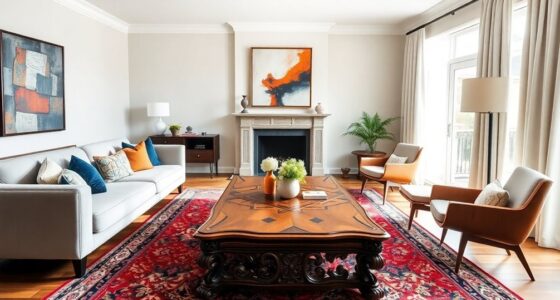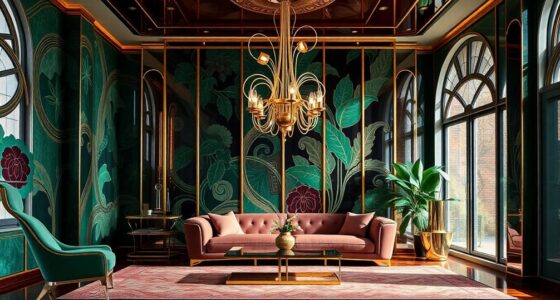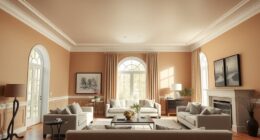If you're exploring 1950s houses, you'll notice they showcase a unique mid-century modern style. These homes typically feature single-story layouts with low-pitched roofs and large windows that connect the indoors to the outdoors. Open floor plans are common, allowing for fluid movement between living and dining areas, while L-shaped designs create subtle separations. This era also brought kitchen innovations that emphasized functionality and style. Overall, the design reflects a blend of simplicity and elegance that resonates even today. Stick around, and you'll uncover more fascinating details about this retro design journey.
Key Takeaways
- 1950s houses often feature single-story layouts with low-pitched roofs, promoting a streamlined and accessible design aesthetic.
- Iconic mid-century modern elements include large windows and open floor plans, enhancing natural light and indoor-outdoor connectivity.
- Vibrant color palettes and atomic age decor, such as starburst clocks, reflect the era's playful and optimistic spirit.
- Kitchen innovations, including electric appliances and colorful metal cabinets, transformed culinary spaces into stylish and functional areas.
- The architectural heritage of 1950s homes is now recognized and preserved, highlighting their cultural significance in American history.
Architectural Characteristics

When you explore the architectural characteristics of 1950s house styles, you'll notice a distinctive blend of functionality and aesthetic appeal. These homes often feature a single-story layout with low-pitched gable or hipped roofs, creating a streamlined look. Large windows and sliding glass doors enhance indoor-outdoor connectivity, allowing natural light to flood the spaces. The open floor plans emphasize fluidity, with dining areas seamlessly integrated into living rooms. An L-shaped layout is common, suggesting separation without closing off spaces. Built-ins, like bookcases and vanities, maximize utility, while materials like brick, wood, and stucco blend harmoniously with the surroundings. The use of durable roofing materials ensures these homes maintain their charm for years to come. Additionally, the design principles of the era often reflected the mid-century modern design movement, which showcased sleek lines and vibrant color palettes that influenced the overall aesthetic.
Interior Design Elements

As you delve into the interior design elements of 1950s house styles, you'll discover a vibrant tapestry of colors, textures, and furnishings that define the era. Earthy tones like browns and mustard yellows create warm spaces, while bold colors pop in kitchens with pastel cabinets and playful patterns. Furniture features sleek silhouettes, with iconic pieces like the Eames Lounge Chair adding style and comfort. Natural materials such as rattan and wicker bring a boho chic vibe, and mirrored surfaces elevate the glam factor. Accessories, like starburst clocks and abstract artwork, reflect the era's fascination with the Space Age. Notably, the atomic age design also influenced decor choices, infusing spaces with optimism and futuristic themes. These elements come together to form inviting, playful environments that capture the spirit of the 1950s, often incorporating vintage accessories that echo the charm of earlier design aesthetics.
Spatial Layout and Functionality
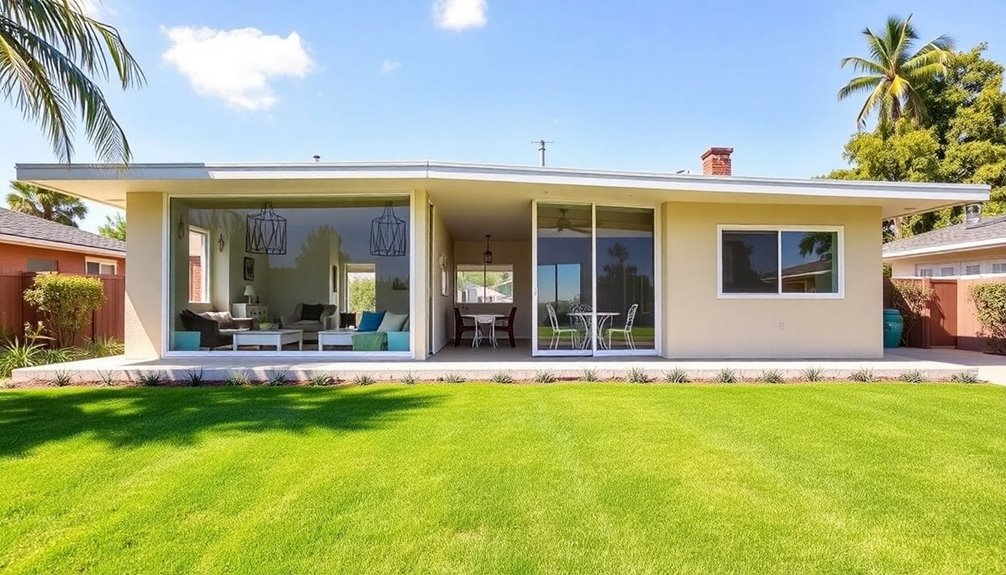
The spatial layout and functionality of 1950s homes reflect a thoughtful design aimed at enhancing everyday living.
These homes often featured zoned living spaces that grouped public areas—like the kitchen, living room, and dining room—separately from private spaces such as bedrooms. This zoning provided necessary privacy while allowing for flexible room use due to size constraints.
Many designs included vestibules or direct entries into the living room, promoting efficient traffic patterns and informal family interactions. The living room served as a multifunctional hub, often integrated with dining areas to foster connection.
Large picture windows and sliding glass doors blurred the lines between indoors and outdoors, maximizing natural light and making spaces feel open and inviting. Furthermore, the flexibility in ranch house design allowed for multiple alterations over time to meet evolving family needs.
Kitchen Innovations
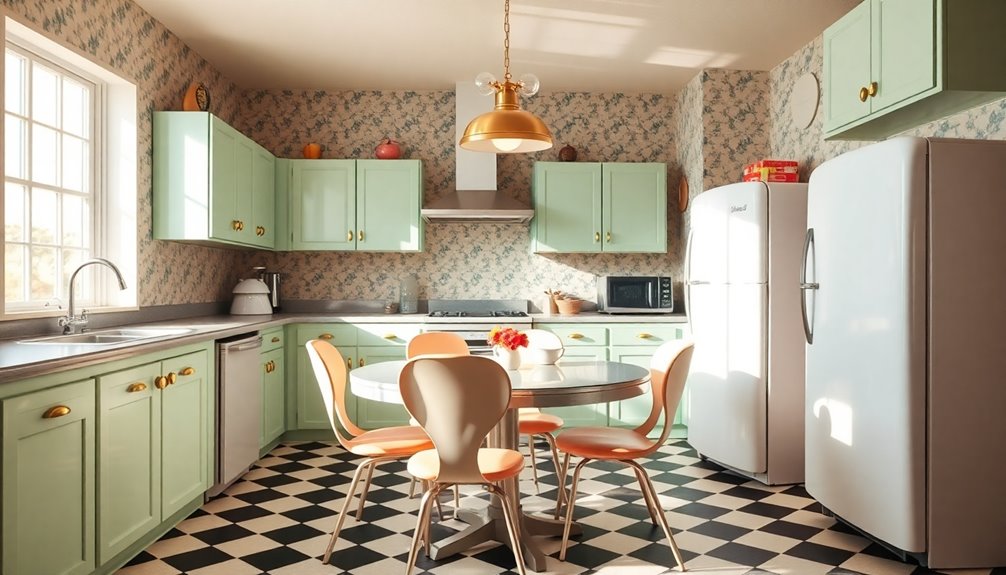
Kitchen innovations in the 1950s transformed how families cooked and interacted in their homes.
You'd enjoy the convenience of electric cooktops and the introduction of stainless steel dishwashers, which made cleanup easier.
Thermador's browning microwave and speed cooking oven combined thermal and microwave energy, allowing quicker meals.
Pyrex became a kitchen essential, perfect for mixing and serving, while frozen foods and instant dessert mixes simplified meal prep.
Colorful metal cabinets and Formica counters added flair to your space, alongside vibrant appliances like toasters available in fun colors.
Portable dishwashers and compact toaster ovens streamlined daily chores, making cooking more enjoyable. Additionally, the introduction of built-in refrigeration significantly enhanced kitchen functionality by providing more food storage options.
In this era, kitchens became lively hubs where family meals and gatherings flourished.
Historical Significance
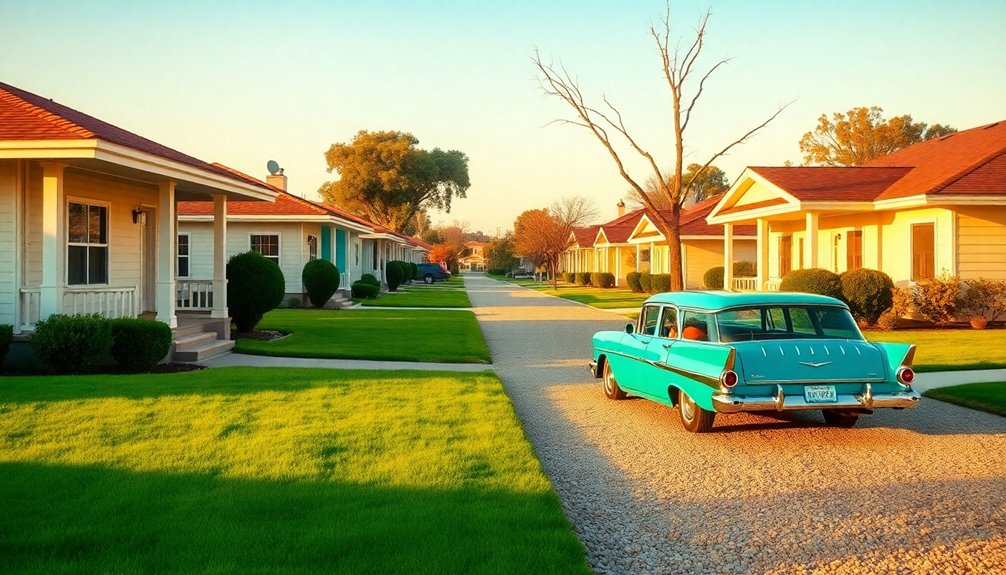
While many people associate the 1950s with vibrant colors and innovative appliances, the era also marked a significant transformation in residential architecture.
The post-war housing boom addressed a critical shortage caused by the Great Depression and World War II. Millions of returning veterans and their families needed homes, leading to an unprecedented construction surge—over 1.6 million new houses in 1955 alone. This rapid expansion of housing coincided with a growing awareness of the importance of emotional regulation, as families sought environments that fostered stability and connection.
Ranch houses emerged as the most popular style, promoting family togetherness with open layouts and integrated spaces. This architecture reflected changing family dynamics, offering flexibility for growing needs. Additionally, the importance of preserving architectural heritage is now recognized, as many of these homes are celebrated for their unique design elements.
Today, these homes are recognized for their cultural significance, with many eligible for historic designation, highlighting their role in shaping modern American life.
Frequently Asked Questions
What Colors Were Popular in 1950S House Exteriors?
In the 1950s, you'd see a variety of vibrant and pastel colors on house exteriors. Turquoise and lime green were eye-catching choices, while pastel pink and pale yellow added a soft touch, especially in warmer regions.
Earth tones like avocado green and woodstone brown created a natural feel. Depending on where you lived, your home might reflect these regional influences, showcasing the lively spirit of the era through its colorful façade.
How Did Landscaping Complement 1950S Home Designs?
You know what they say: "You can't judge a book by its cover."
In the 1950s, landscaping beautifully complemented home designs with lush grassy lawns and concrete patios for relaxation. Bright, bold flowers like roses brought cheer to outdoor spaces.
Clean lines in mid-century modern landscaping echoed home architecture, creating harmony. Plus, features like large windows seamlessly blended indoor and outdoor living, enhancing the overall aesthetic and inviting nature right into your home.
What Types of Materials Were Commonly Used in 1950S Construction?
In the 1950s, construction relied on a mix of materials that shaped homes significantly.
You'd find asbestos used for insulation and roofing, while brickwork and blockwork formed sturdy walls. Concrete strip foundations supported structures, and flooring often featured thermoplastic tiles or concrete slabs.
For windows, galvanised metal was common, while roofing typically used interlocking concrete tiles.
These choices reflected both practicality and the trends of the time, influencing residential design for decades.
Were 1950S Houses Energy-Efficient by Today's Standards?
You might think 1950s houses were energy-efficient, but by today's standards, they fall short.
While they featured compact designs and durable materials, their overall energy performance isn't impressive. Homes from that era consume about 66.0 KBtu per square foot annually, which is significantly higher than modern builds.
To boost efficiency, consider upgrading appliances and implementing operational changes. With the right adjustments, you can enhance your home's energy performance without losing its unique charm.
What Was the Typical Price Range for a 1950S Home?
In the 1950s, a typical home cost around $7,354 unadjusted, translating to about $93,602 today.
You'd notice a significant price jump when comparing it to the 2023 median price of $431,000.
The housing market experienced remarkable growth, driven by post-war economic expansion and suburbanization.
While prices were more accessible back then, regional disparities and concerns about build quality were evident, adding complexity to your home-buying decisions during that era.
Conclusion
In exploring the charm of 1950s houses, you've journeyed through a vibrant tapestry of architectural flair and innovative design. Each element, from the sleek lines to the open spaces, symbolizes a post-war optimism and a longing for connection. These homes invite you to step into a time when simplicity reigned, and style whispered stories of family gatherings and shared meals. Embracing this retro aesthetic allows you to carry a piece of that enduring spirit into your own life.


